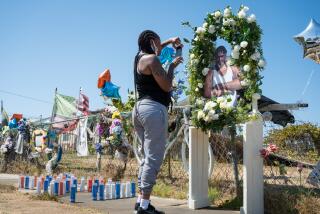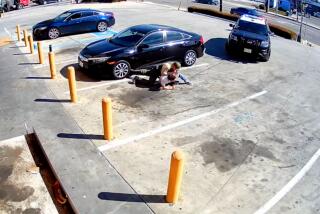Attorney Depicts Williams as a Scapegoat for the Riots : Court: Defense presents final arguments in Denny beating trial. One juror is replaced by an alternate.
The district attorney’s office made Damian Monroe Williams a scapegoat for the riots, hoping his arrest would demonstrate that police and prosecutors were doing their jobs, Williams’ attorney said in court Wednesday.
“Everyone calls this the Reginald Denny beating case,” said Edi M.O. Faal, Williams’ lawyer. “That’s what it is--a beating case.”
The beating is regrettable, he said, but it is not a case of attempted murder or aggravated mayhem--charges that carry a maximum penalty of life in prison.
In a final argument combining sarcasm, eloquence, indignation and wit, Faal’s characterization of prosecution evidence caused the courtroom to erupt in laughter several times.
He said that charges against Williams--who is accused of trying to kill trucker Reginald O. Denny--are overreaching and improper, and that he would show that “no one in this case had a specific intent to kill anyone.”
His summation took nearly the entire day, which began with Superior Court Judge John W. Ouderkirk removing a middle-aged black man from the jury for “good legal cause.” A black woman, who appeared to be in her 30s, was selected at random from the alternate jurors to replace him, leaving the panel with four blacks, four Latinos, three whites and an Asian-American.
Rosalind X Moore, a reporter for the Final Call newspaper published by the Nation of Islam, learned that the man--known only as Juror 347--allegedly discussed the case with others, telling them he would vote to convict Williams.
She contacted a spokesman for Williams’ family, who said he located other witnesses to the statements. Ouderkirk conducted a closed hearing on the allegations, and attorneys for both sides agreed to remove the juror.
Faal did not complete his final argument Wednesday because a juror became ill, and Ouderkirk recessed court early. Faal is to complete his summation today, and Deputy Dist. Atty. Janet Moore will follow with her rebuttal. The case will then go to the jury.
“April 29, 1992, was a tragic day for everyone,” Faal said in his West African accent that has become familiar to courtroom regulars. The system had failed, police officers--who had taken an oath to protect the people--fled, and there was a breakdown in the social fabric, he said.
Rather than consider possible criminal charges in that context, Faal said, prosecutors opted to charge Williams with aggravated mayhem and attempted murder, and to arrest him in a “big media event.”
Williams, 20, and Henry Keith Watson, 29, are charged with attempting to murder Denny and with assaulting or robbing seven other people at Florence and Normandie avenues, the intersection where Denny was beaten.
Williams also is charged with aggravated mayhem--intentionally causing permanent disability or disfigurement--for allegedly hitting Denny in the head with a brick.
Faal raised questions about the testimony of the prosecution’s witnesses and sought to discredit the evidence used to support various charges.
He dismissed gas station cashier Gabriel Quintana, a critical prosecution witness, as a man with a motive to lie because Williams allegedly had attacked him. Quintana testified that he saw Williams hit Denny with a brick three times. Williams then joined a crowd looting the station and beat Quintana, the attendant sad.
Potentially more damaging, however, Quintana testified that he had heard Williams say before the verdicts in the first trial of the officers accused of beating Rodney G. King were announced that he was going “to hit and kill people.” But Quintana did not report the threat until May--a year after the riots--although he had talked to police at least three times earlier, Faal said.
“The prosecution knows they cannot get a conviction on attempted murder without a specific intent to kill,” Faal said. What better way to get it, he asked, than by bringing Quintana to report Williams’ alleged threat.
No one else says Williams hit Denny three times with a brick, Faal said. Quintana also changed his testimony on other key points, Faal said, telling the jury it could not determine “any issue in this case based on the testimony of that gentleman.”
Phillip Davis, a defense witness who assisted trucker Larry Tarvin at the intersection, testified that Quintana could not have seen the attack on Denny because the cashier already was under attack by rioters.
“Davis had everything to lose and nothing to gain by coming to court, and my learned friend savaged him,” Faal said, referring to Deputy Dist. Atty. Lawrence C. Morrison, who brought out that Davis had used a false name on a driver’s license.
A native of Gambia, Faal studied law in London. He frequently referred to Moore or Morrison as “my learned friend.”
Faal said he was “frustrated by the injustice of this case” because prosecutors filed charges of robbery and assault with a deadly weapon when there was no robbery and no evidence of a deadly weapon in some alleged assaults.
“The most outrageous of all the charges,” Faal said, is that Williams robbed Denny. “No property was taken whatsoever.”
Faal accused prosecutors of trying to incite the jury’s passions by repeatedly showing photos of Denny’s bloody face and videotape of contractor Fidel Lopez, whose genitals were spray-painted by rioters.
“The (prosecution’s) purpose is very clear,” he said. “If your passions are invoked, you would get angry and convict these defendants. There are no children in the jury box. That is why that kind of appeal will fail.”
Although prosecutors maintained from the outset that identity was not an issue in the trial, Faal said, “from Day 1 to the last day, they’ve done nothing but talk identification.”
He noted that prosecutors focused on a stain on a shirt allegedly worn by Williams. A videotape shot at 5:15 p.m. on the day of the beatings shows a shirt with a stain. Fifteen minutes later, the man prosecutors say is Williams has no stain on his shirt, Faal said. Then, 25 minutes later, the stain reappears on the shirt of the man on the videotape, he noted.
“This is one of the worst riots in U.S. history,” Faal said, “and a rioter decides: ‘Oh, I need fresh clothes.’ The last thing on an active rioter’s mind is changing shirts two or three times. There is a series of events here that no one has given a reasonable explanation for.”
If there is uncertainty established by the T-shirt, then prosecutors have failed to prove Williams’ identity beyond a reasonable doubt, Faal said.
He argued that if prosecutors felt identity was not an issue, they would not have brought an official of Nike Inc. from Beaverton, Ore., to identify a shoe. Nor would they have flown in an assistant principal from Mississippi, where Williams attended school for a year, to identify him by his gait. Faal sarcastically called the witness a “shoulder expert.”
Faal will address attempted murder and aggravated mayhem, the most serious charges that Williams faces, in his final argument today.
More to Read
Sign up for Essential California
The most important California stories and recommendations in your inbox every morning.
You may occasionally receive promotional content from the Los Angeles Times.










